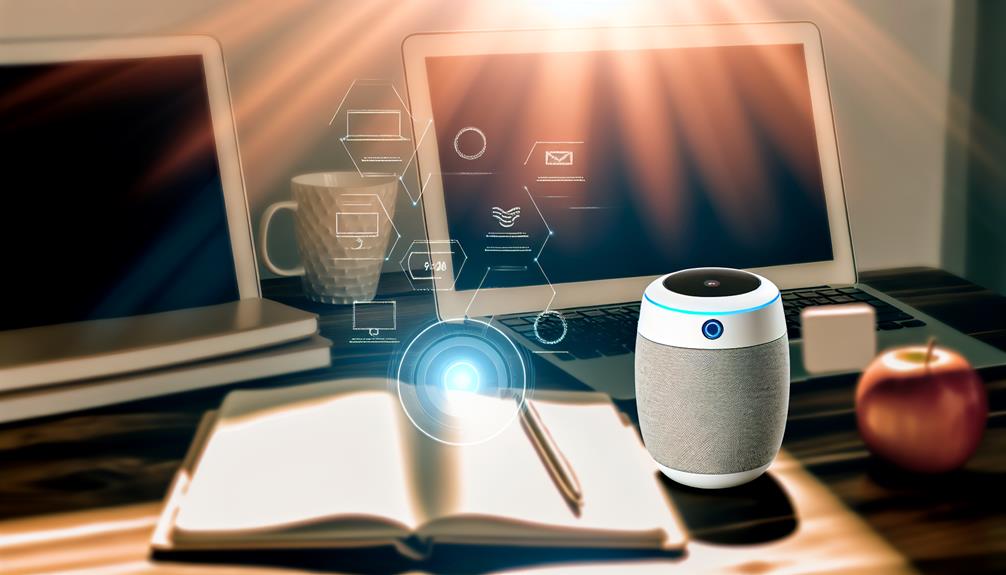10 Essential Automated Tools for Time Management
In today's fast-paced work environment, effective time management is paramount for maximizing productivity. Automated tools can play a critical role in this regard, offering solutions that streamline tasks, enhance collaboration, and provide insightful analytics. Among the myriad options available, ten essential tools stand out for their unique capabilities and user-friendly interfaces. Understanding how these tools can be leveraged to optimize your daily workflow may lead to significant improvements in efficiency and focus. However, the question remains: which of these tools will best meet your specific needs and objectives?
Key takeaways
- Zapier connects multiple applications to automate repetitive tasks, streamlining workflows and enhancing productivity without any coding required.
- RescueTime tracks time spent on tasks and applications, providing insights to optimize work habits and improve time management.
- Toggl offers a user-friendly interface for logging time, generating detailed reports for productivity analysis, and integrates with project management tools.
- Clockify provides robust time tracking for individuals and teams, promoting transparency and collaboration while identifying performance bottlenecks.
- Todoist enables task automation through recurring tasks and reminders, helping users manage deadlines and prioritize effectively.
Todoist
Many individuals seeking to enhance their productivity turn to Todoist, a powerful task management tool designed to streamline daily activities. This platform not only helps users organize their tasks but also incorporates effective task prioritization strategies that are essential for maximizing efficiency. By enabling users to categorize tasks based on urgency and importance, Todoist allows for a clear focus on what truly matters.
To effectively leverage Todoist, users can adopt project management tips that enhance collaboration and accountability. For instance, breaking down larger projects into manageable tasks fosters a sense of achievement as individuals complete each step. Utilizing labels and filters helps users keep track of different projects and deadlines, making it easier to allocate time effectively.
Moreover, Todoist's intuitive design facilitates effortless navigation, ensuring that users can quickly adapt their workflow to changing priorities. The integration of recurring tasks serves as a reminder for ongoing responsibilities, reducing the mental load associated with remembering every deadline.
Ultimately, by embracing Todoist's robust features, individuals can cultivate a productive environment that fosters a sense of community and shared purpose among team members.
Trello
Trello is a powerful tool for organizing tasks efficiently, enabling users to create boards, lists, and cards that visually represent project workflows.
Its collaboration features facilitate teamwork by allowing multiple users to share boards, assign tasks, and track progress in real time.
This integration of task management and collaboration makes Trello an invaluable resource for both individual and team productivity.
Organizing Tasks Efficiently
A well-structured task management system can greatly enhance productivity and clarity in both personal and professional environments. Trello, as a visual project management tool, facilitates effective organization of tasks through its intuitive interface, enabling users to adopt task prioritization strategies that align with their goals.
Using boards, lists, and cards, Trello empowers users to break down complex projects into manageable components, thereby optimizing their digital workflows. Here's a concise comparison of task organization methods:
| Method | Description |
|---|---|
| Kanban | Visual representation of tasks in progress |
| To-Do Lists | Simple, linear task lists for quick reference |
| Prioritized Backlog | Focus on high-impact tasks first |
| Time Blocking | Allocating specific time slots for tasks |
Employing these strategies within Trello not only helps in clarifying responsibilities but also fosters a sense of community among users. By sharing boards, team members can engage in a unified approach to task management, creating an atmosphere of collaboration and support. Ultimately, Trello streamlines task organization, making it an essential tool for those seeking efficiency and connection in their workflows.
Collaboration Features Overview
Effective task organization naturally leads to enhanced collaboration among team members. Trello offers a robust platform that facilitates seamless team communication, guaranteeing that everyone is on the same page regarding project updates. Its intuitive interface allows users to create boards, lists, and cards that visually represent tasks, making it easy for team members to track progress in real-time.
One of Trello's standout features is its ability to assign tasks to specific individuals, fostering accountability and clarity. Team members can comment directly on cards, enabling instant feedback and discussions about specific aspects of a project. This real-time interaction enhances transparency and makes it easier to address any challenges that may arise.
Additionally, Trello integrates with various tools such as Slack and Google Drive, streamlining communication and document sharing. This integration guarantees that team members can access crucial information without maneuvering away from the platform, further enhancing collaboration.
RescueTime
RescueTime is a powerful tool designed to track your productivity by monitoring how you spend your time on various tasks and applications.
By setting specific goals, users can effectively focus their efforts on improving efficiency and reducing distractions.
Additionally, the analytical insights provided by RescueTime facilitate a deeper understanding of time usage, enabling informed adjustments to enhance overall productivity.
Track Your Productivity
To enhance productivity, leveraging tools that monitor and analyze work habits can be invaluable. One such tool is RescueTime, which specializes in time tracking and provides insightful productivity metrics. By automatically tracking the time spent on applications and websites, RescueTime offers users a clear view of how their hours are allocated throughout the day.
This data empowers individuals and teams to identify patterns in their work habits, revealing both strengths and areas for improvement. For instance, users may discover that they are spending excessive time on non-essential tasks, which can lead to feelings of frustration and overwhelm. With this awareness, adjustments can be made to optimize time allocation effectively.
Moreover, RescueTime's detailed reports not only highlight productivity peaks but also provide suggestions for maintaining focus and reducing distractions. By integrating this tool into daily routines, users can cultivate a more structured approach to work, fostering a sense of belonging within a community that values efficiency and effectiveness.
Ultimately, tracking productivity is about creating an environment where individuals can thrive, making it easier to achieve shared goals and aspirations.
Set Goals Effectively
While understanding productivity patterns is essential, setting clear and achievable goals is equally important for maximizing efficiency. Effective planning begins with defining specific objectives that align with your broader aspirations. By employing structured goal setting, you create a roadmap for success, paving the way for focused effort and measurable outcomes.
To enhance your goal-setting process, consider the following framework:
| Goal Type | Description |
|---|---|
| Short-term Goals | Achievable within weeks or months |
| Long-term Goals | Targets set for the year or beyond |
| Personal Goals | Focused on self-improvement or hobbies |
| Professional Goals | Career advancements or skill development |
Incorporating this structure into your approach helps guarantee that you remain motivated and accountable. By breaking down larger ambitions into manageable tasks, you foster a sense of belonging to a community aiming for excellence. Remember, effective planning is not just about setting goals, but also about reviewing and adjusting them as needed. Cultivating this practice will ultimately enhance your productivity and lead to sustained success in both personal and professional domains.
Analyze Time Usage
Understanding your time usage is an essential step in achieving the goals you have set. By employing tools like RescueTime, you can engage in effective time tracking that reveals patterns in how you allocate your hours. This data-driven approach allows for thorough productivity analysis, helping you identify areas for improvement and optimize your workflow.
RescueTime operates seamlessly in the background, gathering insights on your activities across various applications and websites. With this information, you can pinpoint distractions and recognize productive periods, fostering a more intentional use of your time.
The visual reports generated by the tool not only provide clarity but also empower you to make informed decisions about your daily routines.
In a community that values growth and accountability, leveraging tools like RescueTime can foster a sense of belonging among peers working towards similar objectives. By sharing insights and strategies for improvement, you create an environment where collective progress thrives.
Ultimately, understanding your time usage through effective tools enhances both personal productivity and the potential for collaborative success, aligning your daily actions with your long-term aspirations.
Clockify
Among the myriad of time management tools available today, Clockify stands out as a robust solution for individuals and teams seeking to optimize productivity. This all-encompassing time tracking tool offers a suite of clockify features designed to enhance efficiency and accountability. Users can effortlessly track time spent on various tasks, generate detailed reports, and analyze performance metrics, all from a user-friendly interface.
The clockify benefits extend beyond simple time tracking; it fosters a culture of transparency and collaboration within teams. By providing insights into how time is allocated, teams can identify bottlenecks and streamline processes, leading to improved workflow.
Additionally, Clockify's ability to integrate with popular project management tools ensures seamless operation, allowing users to manage their time without disrupting their current workflows.
Clockify also offers flexibility with its mobile app, enabling users to log hours on-the-go, making it an ideal solution for remote teams and freelancers.
As individuals and organizations continually work to enhance productivity, Clockify emerges as a valuable ally, helping users make informed decisions about their time management practices while fostering a sense of belonging within their teams.
Asana
Asana is a powerful tool for task organization, enabling users to create, assign, and prioritize tasks effectively.
Its collaboration features facilitate seamless communication among team members, enhancing productivity and accountability.
Additionally, Asana's ability to integrate with various applications streamlines workflows, making it a versatile choice for time management.
Task Organization Features
Effective task organization is essential for enhancing productivity and guaranteeing that teams remain aligned on their objectives. Asana offers robust features that empower users to implement effective task prioritization strategies. By categorizing tasks into projects, teams can focus on what truly matters, allowing for a more streamlined approach to workload management.
The ability to assign priority levels to each task guarantees that critical items are addressed promptly, while less urgent tasks can be scheduled accordingly. This prioritization not only helps in meeting deadlines but also fosters a sense of accomplishment as team members progress through their tasks.
Moreover, Asana's deadline management techniques enhance accountability within teams. Users can set due dates and reminders, guaranteeing that everyone is aware of their responsibilities and timelines. This clarity encourages team members to support each other in meeting shared goals, fostering a culture of collaboration.
Collaboration Tools Available
Releasing the potential of teamwork is essential in today's fast-paced work environment, and Asana offers a suite of collaboration tools designed to facilitate seamless communication among team members. By enhancing team communication and ensuring project alignment, Asana empowers groups to work more effectively together.
The following table outlines key features of Asana that support collaboration:
| Feature | Purpose |
|---|---|
| Task Comments | Enable discussions directly on tasks, fostering real-time feedback. |
| Project Dashboards | Provide a visual overview of project progress, ensuring everyone is aligned. |
| File Attachments | Allow team members to share important documents and resources easily. |
| Team Calendars | Synchronize deadlines, ensuring that all members are aware of timelines. |
These tools not only streamline workflows but also cultivate a sense of belonging within teams. By utilizing Asana's features, members can communicate more effectively, leading to improved project alignment and a stronger collective effort. In embracing these collaboration tools, teams can overcome barriers and build a more cohesive work environment, ultimately driving success in their endeavors.
Integration With Other Apps
Integrating Asana with other applications enhances productivity by creating a unified workflow across various platforms. This integration allows users to connect with tools like Slack, Google Drive, and Zapier, maximizing app compatibility and streamlining daily tasks. By centralizing project information, teams can reduce the friction often associated with switching between multiple applications.
The automation benefits provided by these integrations are significant. For instance, users can automate task creation in Asana based on triggers from other platforms, ensuring that important deadlines are never overlooked. This seamless interaction not only saves time but also fosters a sense of community, as team members can collaborate more effectively without the constant need for manual updates.
Moreover, the ability to pull data from various sources into Asana enhances decision-making processes. Teams can visualize project progress and resource allocation without steering away from their primary workspace.
This interconnectedness fosters a collaborative environment, allowing members to feel more engaged and aligned with the team's goals. Ultimately, integrating Asana with other apps is a crucial strategy for those seeking to optimize their time management practices and build a cohesive work culture.
Focus@Will
Focus@Will is a unique productivity tool designed to enhance concentration and minimize distractions through curated music playlists. By leveraging neuroscience, it creates an environment conducive to deep work, helping users stay engaged and productive.
One of the standout focus@will benefits is its ability to customize playlists based on individual preferences and work styles. Users can choose from various genres, each tailored to evoke specific mental states, whether it's calming, energizing, or motivating. This personalization fosters a sense of belonging, as users can find their unique rhythm while working.
Another key feature is the timer function, which encourages users to work in focused intervals, promoting efficient time management. By breaking tasks into manageable segments, users can tackle projects without feeling overwhelmed.
Additionally, focus@will offers insights and analytics, allowing users to track their productivity patterns over time. This reflective practice can cultivate a deeper understanding of one's work habits, leading to improved focus and efficiency.
Zapier
Zapier is a powerful automation tool that enables users to connect various applications and streamline workflows without the need for coding. By leveraging Zapier integrations, individuals and teams can create seamless connections between their favorite apps, enhancing productivity and reducing manual tasks.
With an intuitive interface, users can set up automated workflows—known as "Zaps"—that trigger specific actions based on predefined conditions. For example, you can automatically save email attachments to cloud storage, or add new contacts from forms directly into your CRM.
This level of workflow automation not only saves time but also minimizes the risk of errors that come with repetitive tasks.
Zapier's vast library of app integrations allows users to customize their automation strategies, ensuring they can tailor their workflows to meet unique needs.
As you implement Zapier into your routine, you foster a sense of belonging within a community of professionals who prioritize efficiency and collaboration.
Notion
Notion has emerged as a versatile all-in-one workspace that brings together notes, tasks, databases, and calendars, allowing users to organize their projects and ideas seamlessly.
Its flexibility makes it an ideal choice for individuals and teams alike, fostering collaboration and creativity.
With an array of Notion templates, users can kickstart their workflows, whether for personal projects or team initiatives.
Notion databases enable users to manage information efficiently, while Notion widgets enhance functionality by providing quick access to essential tools.
The platform's numerous Notion integrations streamline processes, connecting with other applications to create a cohesive ecosystem.
For those engaged in Notion brainstorming sessions, the platform offers an intuitive interface that encourages idea sharing and refinement.
Additionally, Notion project management capabilities allow users to track progress visually, ensuring accountability and transparency within teams.
The power of Notion lies in its customization options, enabling users to tailor their Notion workspace to meet specific needs.
With a wealth of Notion tutorials available, users can quickly learn how to harness the full potential of this dynamic tool, creating a productive environment that nurtures collaboration and growth.
Google Calendar
As individuals and teams increasingly seek effective ways to manage their time, Google Calendar stands out as a powerful scheduling tool that enhances productivity.
With its intuitive interface and robust features, it fosters collaboration and guarantees that important moments are never overlooked.
Here are three compelling reasons to embrace Google Calendar in your time management strategy:
1. Event Reminders: Customize notifications to remind you of upcoming commitments, making certain you stay on track and never miss a beat.
2. Calendar Sharing: Effortlessly share your calendar with colleagues, friends, or family, promoting transparency and fostering a sense of community.
This feature strengthens relationships by keeping everyone aligned on schedules.
3. Smart Scheduling: Use the "Find a Time" feature to identify ideal meeting slots, minimizing back-and-forth communication and maximizing efficiency.
Toggl
Toggl is a robust time-tracking tool that empowers individuals and teams to gain insights into how their time is spent. By providing a user-friendly interface, Toggl simplifies the process of logging hours, making it easier to monitor projects and tasks. This functionality is essential for those seeking to enhance their productivity and guarantee accountability within their workflows.
With Toggl, users can create detailed reports that reveal productivity insights, enabling them to identify areas for improvement. The tool supports various integrations, allowing seamless connections with other applications such as project management software, which enhances its versatility.
One of Toggl's standout features is its ability to categorize time entries, giving users a clear view of how much time is allocated to specific tasks or projects. This categorization fosters a sense of belonging within teams, as everyone can see their collective efforts reflected in the data.
Moreover, Toggl offers mobile and desktop applications, making certain that time tracking is accessible anytime, anywhere. By investing time in utilizing Toggl, individuals and teams can cultivate a more productive environment, ultimately leading to better outcomes and a deeper connection to their work.
Frequently Asked Questions
What Are the Best Practices for Using Automated Time Management Tools?
To optimize automated time management tools, establish clear task prioritization criteria and employ automated reminders consistently. This fosters accountability, enhances productivity, and creates a supportive environment that encourages collaboration and a sense of belonging among team members.
How Can I Integrate Multiple Tools for Better Efficiency?
Like a well-tuned orchestra, integrating multiple tools harmonizes your workflow. Employ efficiency hacks such as API connections and centralized dashboards to streamline processes, ensuring tool integration enhances productivity while fostering collaboration and a sense of belonging.
Are There Any Free Alternatives to These Paid Tools?
Several free alternatives exist for effective time management, including free time tracking apps like Toggl and Clockify. Additionally, budget management software such as Mint can enhance financial oversight without incurring expenses, fostering community engagement among users.
How Do I Choose the Right Tool for My Workflow?
Steering through the vast landscape of productivity tools requires clarity. Consider tool features that align with your tasks, while also reflecting on user preferences that resonate with your unique workflow, ensuring a harmonious fit for best efficiency.
Can Automated Tools Improve Work-Life Balance Effectively?
Automated tools can considerably enhance work-life harmony by streamlining tasks and reducing time spent on repetitive activities. This productivity enhancement fosters a healthier balance, allowing individuals to focus on personal and professional fulfillment more effectively.



